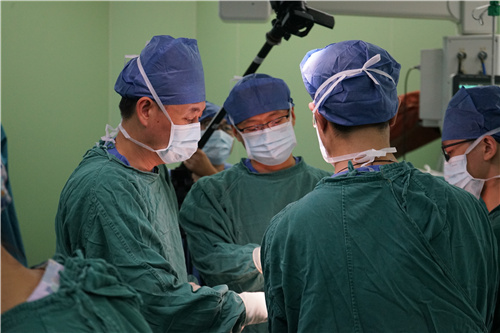
On Sept. 30, 2021, Professor Zhou Zongke’s team from the Department of Orthopedics successfully implanted a 3D printed trabecular bone matched cementless knee prosthesis for a patient with knee osteoarthritis. After literature review, it has been found that this technology was the first in the world. On Oct. 19, the patient could walk normally with functional knee joints.
The female patient aged 58, has suffered from knee pain for many years. In the past two years, her symptoms were obviously worsened, affecting her quality of life seriously. She was diagnosed as knee osteoarthritis in many other hospitals and treated with analgesic drugs, physiotherapy and intra-articular injection of drugs, but the results were unsatisfactory.
In September this year, the patient signed up for the clinical research project of total knee replacement with cementless knee prosthesis led by West China Hospital. After comprehensive evaluation, it was found that the patient’s knee osteoarthritis had reached the end stage, indicating that only surgical treatment could treat her knee osteoarthritis. On the afternoon of Sept. 30, Professor Zhou’s team successfully conducted the left knee replacement. When the cementless knee prosthesis was implanted during the operation, no bone cement was required to fix the prosthesis, and the operation time was significantly shortened. The postoperative X-ray radiography showed that the prosthesis was perfectly matched with bone and fixed well. The deformity of the patient’s left knee was completely corrected, and the range of motion of the knee proved good. At last, the knee problem suffering the patient many years had successfully been solved.
At present, most of the knee prostheses used clinically are bone-cement fixed prostheses. Bone cement can fix the knee prostheses on the bone interface. However, there are some limitations, such as the monomer of bone cement is toxic. In addition, the bone cement may cause osteolysis of bone. Moreover, the bone cement may occur deformation and degeneration with the time goes by, which may reduce the ability to bear stress of the protheses.
Without the use of bone cement during operation, the cementless knee prosthesis implanted allows for mechanical fixation, that is, the prosthesis is closely bound with bone, and the bone tissues will grow into the micropores on the surface of the prosthesis, thus realizing the transformation from mechanical fixation to biological fixation, and finally obtaining good fixation through osseointegration. This is expected to obtain a longer prosthesis survival. And the 3D printed trabecular bone matched cementless knee prosthesis, the first case over the world, has three-zone structure with specific topological morphology designed based on the structural characteristics of bone in different regions of the proximal tibia and the mechanical characteristics of eccentric loading, so as to realize the uniform stress of the bone interface and obtain the same growth of the bone tissues. In addition, the cementless knee prosthesis avoids the occurrence of bone cement-related complications, shortens the operation time, and preserves bone tissues. Therefore, the postoperative pain of patients is relieved, and the incidence of perioperative complications is reduced, contributing to the rapid recovery of patients after operation.